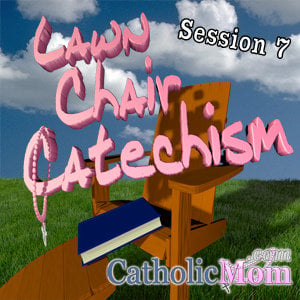
Welcome to the 7th session of Lawn Chair Catechism, using Forming Intentional Disciples: The Path to Knowing and Following Jesus, by Sherry Weddell (Our Sunday Visitor, 2012).
A few notes:
- If you're joining us for the first time this week, welcome! Feel free to check out the previous chapter's discussions on our Lawn Chair Catechism landing page.
- You'll be able to leave comments and/or leave your link at the end.
- You do not have to read the book to participate. Check out our discussion guide. There's plenty to get started with if that's all you use (one page a week).
- You can still get that terrific $10+free shipping deal from Our Sunday Visitor. And if you're like me, you've pointed at least five friends to this book during the course of reading it.
This week, we'll be covering Chapter 6: The Second Threshold: Curiosity.

Summary:
“Curiosity” is when the individual shows an interest in the Catholic faith in a casual way. The individual is not yet actively seeking Christ – he or she may not even know who Christ is.
It is essential that we help people wrestle with the first, most crucial issue of a personal God. Those who don’t believe in a personal God and the possibility of a relationship with that God will never be able to move beyond the threshold of curiosity.
It is very important that we tread lightly. You can easily quench inquiries by drowning a teaspoon full of curiosity with a gallon of answers.
How to arouse curiosity? A life of faith – prayer, trust in God, works of mercy – is inherently curious. Whether through word or action, one of the most helpful ways to arouse curiosity is to pose a question.
Jesus was a master of asking questions that made you sit up and think again. Jesus didn’t so much run “Q and A” sessions as “Q and Q” sessions. In fact, he almost never gave a straight answer to a straight question.
. . . The point of this approach is to allow the natural curiosity of the human person to draw him or her to an encounter with the person of Jesus.
Who’s curious? Extensive statistical and field research has uncovered a sobering reality: The bulk of Catholics in the pews today are at these early, passive stages of faith. A 2010 study found that only 65% of Catholics polled recognized Easter as a religious holiday, and only 37% listed the Resurrection as the meaning of that day. Sherry Weddell reports:
. . . as we led these sessions, however, we slowly came to realize that a significant number of Catholic leaders, even those deeply interested in evangelization, think of the faith as essentially passive.
. . . All the statistical indicators suggest that the majority of our “active” members are in the early and essentially passive stages of spiritual development, such as trust and curiosity.
An evangelizing parish must actively change to become welcoming to those curious about the faith, in order to meet the currently un-met spiritual needs of parishioners, lapsed Catholics, and outsiders.
For discussion:
In your own faith:
- Can you remember when you became “curious” about the faith – whether as a convert, revert, or cradle Catholic just waking up to mature discipleship?
- How would you explain the difference between an active and passive faith?
In your parish:
- If a newcomer walked into your parish today, curious about the Catholic faith, would someone actively welcome him? Introduce him to others?
- Who would help him answer his questions?
Join the discussion!
We'll be "talking" in the combox, too, so please leave your thoughts there as well!
'); // ]]>
About the Author

Sarah Reinhard
When she’s not chasing kids, chugging coffee, or juggling work, Sarah Reinhard’s usually trying to stay up read just one … more … chapter. She writes and works in the midst of rural farm life with little ones underfoot. She is part of the team for the award-winning Catholic Mom’s Prayer Companion, as well as the author of a number of books.


.png?width=1806&height=731&name=CatholicMom_hcfm_logo1_pos_871c_2728c%20(002).png)
Comments